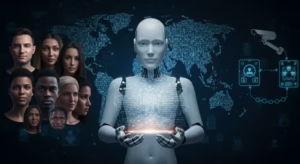AI and Human Rights: A Technological Dilemma

The blog post AI and Human Rights: A Technological Dilemma explores the complex relationship between AI and human rights. It begins by understanding how AI affects human rights, highlighting the potential threats and benefits of technological advancements. The article further analyzes algorithmic discrimination in AI systems, shedding light on biases that can arise and the implications for marginalized groups. Emphasizing the necessity of ethical technology in AI development, it argues that safeguards must be established to protect human rights. Finally, the post calls for action to ensure fairness in AI implementations, advocating for inclusive practices and accountability in the tech industry to promote a just future. Through these discussions, the post underscores the important intersection of AI and human rights, encouraging readers to consider the broader impact of technology on societal principles.
Understanding The Impact Of AI And Human Rights

The intersection of AI and human rights presents a complex landscape where technological advancement must be balanced with ethical considerations. As AI systems increasingly permeate everyday life, they have the potential to significantly enhance or undermine personal freedoms and digital rights. The rapid deployment of AI technologies in various sectors raises critical questions about accountability, transparency, and the potential for systemic bias. It is essential for stakeholders, including governments, organizations, and the tech industry, to understand the implications of AI on human rights to develop frameworks that protect individuals from discrimination and violations.
Key Concepts to Consider
- Accountability in AI Systems
- Transparency of Algorithms
- Impact on Free Speech
- Data Privacy and Security
- Prevention of Discrimination
- Equitable Access to Technology
- Global Digital Rights Protection
Moreover, as we navigate the challenges posed by AI and human rights, it is crucial to advocate for robust policies that emphasize the respect and protection of digital rights. Governments and institutions should collaborate with tech developers to ensure that AI technologies are designed with ethical principles at their core. Only by prioritizing human rights in technology can we foster a digital ecosystem that truly serves and uplifts all individuals, minimizing the risk of potential abuses and fostering public trust in artificial intelligence.
Analyzing Algorithmic Discrimination In AI Systems

In the evolving landscape of digital technology, the intersection of AI and human rights emerges as a critical concern. The phenomenon of algorithmic discrimination poses significant challenges that can lead to undesirable societal consequences. As artificial intelligence systems increasingly permeate various sectors, understanding how AI bias manifests becomes essential for fostering equitable outcomes. Addressing these biases requires a comprehensive analysis and a commitment to ethical practices in technology development.
Impact of AI Bias Across Different Sectors
| Sector | Type of Discrimination | Example |
|---|---|---|
| Healthcare | Race-based | Predictive analytics favoring certain demographics |
| Employment | Gender-based | Job recruitment algorithms favoring male candidates |
| Criminal Justice | Socioeconomic | Risk assessment tools biased against low-income individuals |
| Finance | Age-based | Loan eligibility criteria disproportionately affecting younger applicants |
The implications of algorithmic discrimination are profound, impacting real-life situations and amplifying existing inequalities. Thus, it becomes imperative to identify the mechanisms through which these biases occur. The development of AI systems must be subject to scrutiny, as the algorithms underlying these technologies may learn from historical data riddled with bias. Failure to address these systemic issues risks perpetuating cycles of discrimination and adversely affecting marginalized communities.
Steps to Identify Algorithmic Discrimination
- Examine the training data for bias and representation.
- Assess algorithm outputs for fairness across different demographics.
- Monitor outcomes and performance metrics regularly.
- Incorporate diverse perspectives during AI development.
- Engage with affected communities to gather feedback.
- Conduct external audits by independent organizations.
- Revise and retrain algorithms based on findings.
To mitigate the impact of AI bias, the role of ethical technology becomes paramount. Engaging in ethical practices not only promotes fairness but also establishes a foundation for accountability in AI systems. Businesses, developers, and policymakers must collaborate to ensure that ethical guidelines are consistently applied during the development process. Fostering a culture of transparency and responsibility can significantly enhance public trust and pave the way for innovative solutions to societal challenges.
Common Examples of AI Bias
Algorithmic discrimination frequently manifests in various real-world scenarios. Examples include biased hiring practices, where recruitment algorithms might favor specific demographics, or biased healthcare algorithms that lead to unequal treatment for different racial groups. Recognizing these disparities is the first step in counteracting the effects of AI bias and advocating for more inclusive AI technologies.
The Role of Ethical Technology
As the field of artificial intelligence evolves, implementing ethical technology principles becomes essential in combating algorithmic discrimination. By prioritizing ethics, organizations can ensure that AI applications promote fairness, accountability, and transparency. This commitment not only addresses immediate biases but also contributes to a broader societal understanding of the critical link between AI and human rights.
The Necessity Of Ethical Technology In AI Development

As artificial intelligence (AI) continues to evolve, the intersection of AI and human rights becomes increasingly critical. With the immense power to influence various facets of society, AI must be developed with a firm ethical foundation. This is essential not only for protecting individual freedoms but also for preserving the integrity of digital rights. Ethical technology serves as a guiding principle that helps navigate the complexities involved in AI deployments while respecting human dignity and privacy.
Best Practices For Ethical AI
- Incorporate diverse perspectives in AI development teams.
- Implement transparent algorithms that can be audited.
- Establish clear guidelines for data usage and consent.
- Conduct regular assessments to identify biases in AI systems.
- Engage with stakeholders, including human rights organizations.
- Promote accountability for AI decisions and outcomes.
- Educate users about their digital rights and AI technologies.
By adopting these best practices, organizations can foster an environment where ethical technology thrives. Such an approach not only safeguards human rights but also promotes trust among users. The importance of placing ethics at the forefront of AI development cannot be overstated; it is essential for ensuring that technological advancements contribute positively to society rather than exacerbate inequalities.
Ultimately, embracing ethical technology in AI development is about more than just compliance; it reflects a commitment to nurturing a society where digital rights are upheld. As stakeholders begin to recognize the implications of their algorithms and data processes, they will be better equipped to make decisions that honor the fundamental principles of human rights. The path toward ethical AI is not just a technological imperative but a moral one, paving the way for a future that respects and promotes human dignity.
Ensuring Fairness In AI Implementations

As we increasingly integrate artificial intelligence into various aspects of our lives, it becomes vital to recognize the implications of AI and human rights. Ensuring that AI systems operate fairly and do not perpetuate algorithmic discrimination is critical. The technologies we develop should not only comply with ethical standards but also promote inclusivity and equity, safeguarding human rights across diverse communities. Organizations must commit to transparency and accountability in their AI implementations to foster trust and reduce biases embedded in these systems.
Actionable Steps To Promote AI Fairness
- Conduct Regular Bias Audits: Implement periodic assessments of AI algorithms to identify any potential biases that could lead to discrimination.
- Engage Diverse Stakeholders: Involve individuals from various backgrounds in the development process to ensure a comprehensive understanding of the societal impacts of AI.
- Establish Clear Guidelines: Develop and enforce robust policies for ethical AI use that prioritize human rights.
- Invest in Education and Awareness: Foster awareness and understanding of AI and human rights among AI practitioners and the public.
- Promote Open-source Solutions: Encourage the use of open-source AI tools that allow for scrutiny and modification by the community, enhancing accountability.
- Facilitate Public Dialogue: Organize forums for discussion around AI ethics, allowing for community feedback and participation in decision-making processes.
Implementing these strategies can help bridge the gap between technological advancement and the preservation of human rights, ensuring that AI serves the greater good of society rather than exacerbating existing inequalities. By taking proactive measures to identify and combat algorithmic discrimination, we can create a future where technology empowers all individuals and maintains the dignity inherent to human rights.
Briefing Document: AI and Human Rights: A Technological Dilemma
Artificial intelligence / humanaifuture.com
🎧 Listen to the Podcast
Want to explore this topic in more depth? Listen to the full podcast for more insights and expert commentary.
▶️ Play on Google DriveNo sign-up needed — just click and listen.
What is algorithmic discrimination and how does AI bias manifest?
Algorithmic discrimination occurs when AI systems produce unfair or biased outcomes, amplifying existing inequalities. AI bias can manifest in various sectors: in healthcare, leading to race-based predictive analytics; in employment, with gender-biased job recruitment algorithms; in criminal justice, through socioeconomic biases in risk assessment tools; and in finance, with age-based loan eligibility criteria. These biases often stem from historical data that is already riddled with systemic prejudices.
What steps can be taken to identify algorithmic discrimination?
Identifying algorithmic discrimination requires a systematic approach. Key steps include: examining training data for bias and representation, assessing algorithm outputs for fairness across different demographics, regularly monitoring outcomes and performance metrics, incorporating diverse perspectives during AI development, engaging with affected communities for feedback, conducting external audits by independent organizations, and revising and retraining algorithms based on findings.
Why is ethical technology essential in AI development?
Ethical technology is crucial in AI development to protect individual freedoms and preserve digital rights. It serves as a guiding principle to navigate the complexities of AI deployments while respecting human dignity and privacy. By integrating ethical considerations from the outset, organizations can ensure that AI advancements contribute positively to society, rather than exacerbating inequalities, and build public trust.
What are some best practices for developing ethical AI?
Best practices for ethical AI development include: incorporating diverse perspectives in AI development teams, implementing transparent and auditable algorithms, establishing clear guidelines for data usage and consent, conducting regular assessments to identify biases, engaging with stakeholders (including human rights organizations), promoting accountability for AI decisions, and educating users about their digital rights and AI technologies.
How can fairness be ensured in AI implementations?
Ensuring fairness in AI implementations involves several actionable steps. These include: conducting regular bias audits of AI algorithms, engaging diverse stakeholders in the development process, establishing and enforcing robust policies for ethical AI use that prioritize human rights, investing in education and awareness about AI and human rights, promoting open-source AI solutions for scrutiny, and facilitating public dialogue around AI ethics.
What is the broader societal importance of addressing AI and human rights?
Addressing the intersection of AI and human rights is not merely a technological imperative but a moral one. It underscores the necessity of balancing technological advancement with ethical considerations to foster a digital ecosystem that serves and uplifts all individuals. By prioritizing human rights, society can minimize the risk of potential abuses, promote public trust, and ensure that AI empowers rather than disadvantages, maintaining human dignity in the age of artificial intelligence.
Who are the key stakeholders responsible for promoting ethical AI and human rights?
Key stakeholders responsible for promoting ethical AI and human rights include governments, organizations, the tech industry (businesses and developers), policymakers, human rights organizations, and the public. Collaboration among these groups is essential to develop robust policies, apply ethical guidelines consistently, foster transparency and responsibility, and ensure that AI technologies are designed with human rights at their core.




